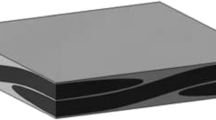Abstract
In this paper, out-of-plane compression of criss-cross composite materials, i.e. materials with ply stacking sequence of [0∘/90∘] n , is studied experimentally and analytically. All these composite materials have some common properties, such as
-
90∘ rotation (around the axis perpendicular to the ply planes) symmetry in macroscopic properties;
-
small ply thickness compared to all other linear dimensions (thickness of the whole material, linear dimensions in the ply plane);
-
significantly different Poisson ratios between the fibre direction/perpendicular-to-the-fibre direction and the two perpendiculars to the fibre directions;
-
ply thicknesses between 30 and 70 μ m.
A constitutive anisotropic elasto-plastic law for this class of materials is proposed, and its validity with reference to Tensylon™ is verified experimentally. Satisfactory agreement is reached, and the viscous nature of the deviations between the model proposed and the experimental results is revealed.










Similar content being viewed by others
Notes
Tables 9 and 10 in this publication contradict each other; we hereinafter compared with Table 10; its data is also reproduced in [8].
The obtained curve was not the desired result of the experiment, and appeared as a result of inaccuracy in the testing program
References
Alderson KL, Evans KE (1992) The fabrication of microporous polyethylene having a negative Poisson’s ratio. Polymer 33(20):4435–4438
Alil L-C, Arrigoni M, Badea S, Barbu C, Bles G, Mostovykh P (2016) Experimental study on viscoelastic properties of ultra-high molecular weight polyethylene composites (Tensylon™). In: Light–weight armour for defence & security (LWAG), October 17–18, Grenoble, France, pp 74–80
Attwood JP, Khaderi SN, Karthikeyan K, Fleck NA, O’Masta MR, Wadley HNG, Deshpande VS (2014) The out-of-plane compressive response of dyneemaⓇ composites. J Mech Phys Solids 70:200–226
Grujicic M, Arakere G, He T, Bell WC, Glomski PS, Cheeseman BA (2009) Multi-scale ballistic material modeling of cross-plied compliant composites. Compos Part B 40:468–482
Lässig T, Nguyen L, May M, Riedel W, Heisserer U, van der Werff H, Hiermaier S (2015) A non-linear orthotropic hydrocode model for ultra-high molecular weight polyethylene in impact simulations. Int J Impact Eng 75:110–122
Lekhnitskii SG (1963) Theory of elasticity of an anisotropic elastic Body. Holden-Day Series in Mathematical Physics, Holden-Day, pp 404
Hill R (1950) The mathematical theory of plasticity. Clarendon Press, Oxford
Nguyen LH, Lässig TR, Ryan S, Riedel W, Mouritz AP, Orifici AC (2015) Numerical modelling of ultra-high molecular weight polyethylene composite under impact loading. Procedia Engineering 103:436–443
O’Masta MR, Deshpande VS, Wadley HNG (2015) Defect controlled transverse compressive strength of polyethylene fiber laminates. Int J Solids Struct 52:130–149
Russell BP, Karthikeyan K, Deshpande VS, Fleck NA (2013) The high strain rate response of ultra high molecular-weight polyethylene: from fibre to laminate. Int J Impact Eng 60:1–9
van der Werff H, Heisserer U (2016) High-performance ballistic fibers: ultra-high molecular weight polyethylene (UHMWPE). In: Chen X (ed) Advanced fibrous composite materials for ballistic protection, pp 80–116
Acknowledgements
The authors would like to greatly thank the technical staff of ENSTA Bretagne, and personally Frederic Montel, for their invaluable help during the experimental campaign. The authors are indebted to Associated Professor Claudiu Badulescu for his involvement in the digital image correlation experiments, and Professor Guilhem Bles for his kind remarks and suggestions. Financial support is also acknowledged: the ERASMUS+ program, that allowed the staying of Luminiţa Alil at ENSTA Bretagne, and the project “IED PROTECT”—Modular composite structures for protection against complex effects of improvised explosive devices, National Program “Partnerships in prioritised areas—PN II”, contract no. 283/2014, that allowed the participation of Luminiţa Alil to the ICSMESP Conference.
Author information
Authors and Affiliations
Corresponding author
Rights and permissions
About this article
Cite this article
Alil, L.C., Arrigoni, M., Badea, S.M. et al. On the Constitutive Law for the Mechanical Quasi-static Response of Criss-Cross Composites (on the Example of UHMWPE). Hum Factors Mech Eng Def Saf 1, 4 (2017). https://doi.org/10.1007/s41314-017-0006-5
Received:
Accepted:
Published:
DOI: https://doi.org/10.1007/s41314-017-0006-5



